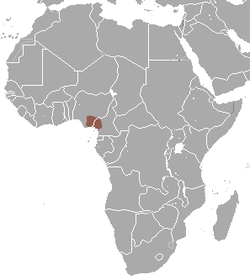Calabar angwantibo
| Calabar angwantibo[1] | |
|---|---|

| |
| Scientific classification | |
| Domain: | Eukaryota |
| Kingdom: | Animalia |
| Phylum: | Chordata |
| Class: | Mammalia |
| Order: | Primates |
| Suborder: | Strepsirrhini |
| Family: | Lorisidae |
| Genus: | Arctocebus |
| Species: | A. calabarensis
|
| Binomial name | |
| Arctocebus calabarensis (Smith, 1860)
| |

| |
| Calabar angwantibo range | |
The Calabar angwantibo (Arctocebus calabarensis), also known as the Calabar potto, is a
The Calabar angwantibo lives in the rainforests of west Africa, particularly in tree-fall zones. In areas where the forest has been cleared, it has been known to live on farmland. Its range covers Cameroon, Nigeria and Equatorial Guinea. The species takes its name from the Nigerian city of Calabar.
The Calabar angwantibo weighs between 266 and 465 grams. It has orangish-yellow fur on its back, grey or white fur on its belly, and a distinctive white line on its forehead and nose. Like other
The Calabar angwantibo is
The Calabar angwantibo's diet consists mainly of insects, especially caterpillars, but it also eats some fruit. It will eat strong-smelling insects that other animals reject. Before eating a caterpillar, the angwantibo wipes it carefully with its hands to remove any poisonous barbs.
When confronted by a
Calabar angwantibos forage for food alone, but each male's territory overlaps that of several females. Angwantibos reinforce social bonds through
In literature
The Calabar angwantibo, along with its close relative the potto, makes an appearance in
The search for an angwantibo is also a minor focus of Gerald Durrell's first book, The Overloaded Ark.
References
External links
- Calabar potto (Arctocebus calabarensis) at The Primata site

